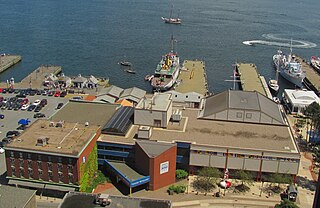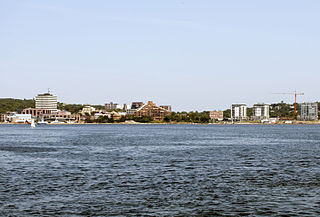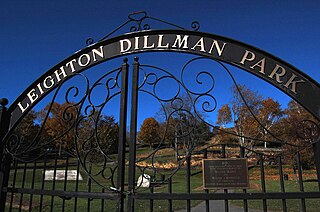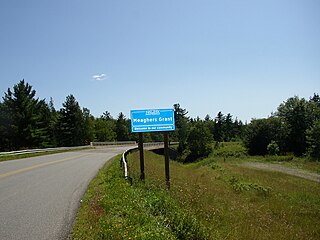
Dartmouth is an urban community and former city located in the Halifax Regional Municipality of Nova Scotia, Canada. Dartmouth is located on the eastern shore of Halifax Harbour. Dartmouth has been nicknamed the City of Lakes, after the large number of lakes located within its boundaries.

The Maritime Museum of the Atlantic is a maritime museum located in downtown Halifax, Nova Scotia, Canada.

The Zatzman Sportsplex is an indoor sports and community centre in Dartmouth, Nova Scotia, opened 1982 and known as the Dartmouth Sportsplex until 2019. It houses an arena, a gymnasium, two swimming pools, and other fitness, leisure and events facilities. It is managed by the Dartmouth Sportsplex Community Association, a non-profit organization which runs the facility on behalf of the Halifax Regional Council.
Route 322 is a collector road in the Canadian province of Nova Scotia.
Route 318 is a collector road in the Canadian province of Nova Scotia.

Downtown Dartmouth is the main central business district of Dartmouth in Halifax, Nova Scotia, Canada. It is part of the Capital District of the Province.

The Dartmouth Commons is an approximately 120 hectares area of land set aside by the government in the late 18th century for the settlers common use in Dartmouth Nova Scotia, Canada. Much of it is maintained by the Halifax Regional Municipality. Today the most prominent area is called Leighton Dillman Park, named after a voluntary keeper of the garden.

Queen Square is an office building in downtown Dartmouth, Nova Scotia, part of the Halifax Regional Municipality. At 18 floors, Queen Square is the tallest building in the downtown Dartmouth area, and is located on Alderney Drive across from Alderney Gate. The building was constructed in 1975.

The Halifax Regional Municipality (HRM) in the Canadian province of Nova Scotia is composed of more than 200 communities and neighbourhoods. As of the 2016 Census, the municipality has a landmass of 549,035 hectares and is home to 403,131 people.
Dartmouth founded in 1750, is a Metropolitan Area and former city in the Canadian province of Nova Scotia.

Lawrencetown is a Canadian rural community in the Halifax Regional Municipality in Nova Scotia, Canada. The settlement was established during the eve of Father Le Loutre's War and at the beginning of the French and Indian War.

Maitland, East Hants, Nova Scotia is a village in East Hants, Nova Scotia. It is home to the historic Lawrence House Museum, which is part of the Nova Scotia Museum. The community was part of the Douglas Township until it was named Maitland after Governor General of Nova Scotia Peregrine Maitland (1828–34) when building the Shubenacadie Canal was first attempted (1826–1831). The Canal was supposed to start at Maitland, Nova Scotia and run through the province to Maitland Street, Dartmouth, the canal being "bookended" by two "Maitland" landmarks.

Lawrence Hartshorne was a Canadian merchant and political figure based in Nova Scotia. He represented Halifax County in the Nova Scotia House of Assembly from 1793 to 1799. He was a Quaker who was the chief assistant of abolitionist John Clarkson in helping Black Nova Scotian settlers emigrate to Sierra Leone in 1792 He is recorded in the Book of Negroes for having freed four slaves.
Lawrence Hartshorne was a hardware merchant and political figure in Nova Scotia. He represented Halifax County in the Nova Scotia House of Assembly from 1825 to 1830.

The Faculty of Medicine at Dalhousie University, also known as Dalhousie Medical School, is a medical school and faculty of Dalhousie University in Halifax, Nova Scotia, Canada.

Royal Artillery (RA) Park, a military installation in Halifax, Nova Scotia, Canada, forms part of Canadian Forces Base Halifax. It is home to the headquarters of 36 Canadian Brigade Group and the official residence of the Commander of the 5th Canadian Division. On the grounds of RA Park are the oldest military officers' mess in Canada (1816) and the Cambridge Military Library, which houses one of the oldest library collections in the country (1810). Royal Artillery Park was initially funded from the conquest of present-day Maine, which was renamed the colony of New Ireland.

Scott Manor House was built sometime between 1769 and 1772 and is now a museum in Bedford, Nova Scotia. It is the second oldest house in the Halifax Regional Municipality, after the Morris House, and was built by Joseph Scott on the land once owned by his brother Captain George Scott. The house was built next to Fort Sackville, which was under the command of Joseph Scott (1760).

The Heritage Trust of Nova Scotia is a non-profit society dedicated to the advocacy for and conservation of Nova Scotia's architectural and cultural heritage. It was founded in 1959, "in response to the proposed demolition of Enos Collins's Halifax House Gorsebrook," a Georgian-style home that once stood on the present site of Saint Mary's University hockey rink. The Trust has advocated for and assisted in the conservation of numerous heritage buildings and districts in Nova Scotia. Notable examples include The Carleton, Morris House, and Historic Properties.

Cambridge Military Library is a public library building in Royal Artillery Park in Halifax, Nova Scotia, Canada which was created in 1886. The building was created to house the garrison library collection, which had been moved from various locations in the city since its creation in 1817. It is the oldest library collection in Atlantic Canada. This building was the social and literary centre of military Halifax. In 1902, the officers of the garrison requested the library be named after the Prince George, Duke of Cambridge.

The Black-Binney House was a former residence built in 1819 in Halifax, Nova Scotia which is now a National Historic Site of Canada. The house was built by John Black (merchant) and is reflective of the Palladian-inspired residences common during the late 18th and early 19th centuries in Eastern Canada. In 1857, Hibbert Binney subdivided the property to build the St. Matthew's United Church (Halifax). In 1965 Sidney Culverwell Oland purchased and renovated the building to house the Nova Scotia Division of the Canadian Corps of Commissionaires.
















